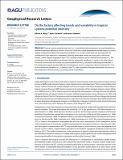| dc.contributor.author | Wing, Allison A. | |
| dc.contributor.author | Emanuel, Kerry Andrew | |
| dc.contributor.author | Solomon, Susan | |
| dc.date.accessioned | 2017-06-01T16:58:48Z | |
| dc.date.available | 2017-06-01T16:58:48Z | |
| dc.date.issued | 2015-10 | |
| dc.date.submitted | 2015-09 | |
| dc.identifier.issn | 00948276 | |
| dc.identifier.uri | http://hdl.handle.net/1721.1/109503 | |
| dc.description.abstract | Tropical cyclone potential intensity (V[subscript p]) is controlled by thermodynamic air-sea disequilibrium and thermodynamic efficiency, which is a function of the sea surface temperature and the tropical cyclone’s outflow temperature. Observed trends and variability in V[subscript p] in each ocean basin are decomposed into contributions from these two components. Robustly detectable trends are found only in the North
Atlantic, where tropical tropopause layer (TTL) cooling contributes up to a third of the increase in Vp. The contribution from disequilibrium dominates the few statistically significant V[subscript p] trends in the other basins. The results are sensitive to the data set used and details of the V[subscript p] calculation, reflecting uncertainties in
TTL temperature trends and the difficulty of estimating V[subscript p] and its components. We also find that 20–71% of the interannual variability in V[subscript p] is linked to the TTL, with correlations between detrended time series of
thermodynamic efficiency and V[subscript p] occurring over all ocean basins. | en_US |
| dc.description.sponsorship | National Science Foundation (U.S.) (grant AGS-1342810) | en_US |
| dc.description.sponsorship | National Science Foundation (U.S.) (AGS Postdoctoral Research Fellowship under award 1433251) | en_US |
| dc.language.iso | en_US | |
| dc.publisher | American Geophysical Union (AGU) | en_US |
| dc.relation.isversionof | http://dx.doi.org/10.1002/2015gl066145 | en_US |
| dc.rights | Article is made available in accordance with the publisher's policy and may be subject to US copyright law. Please refer to the publisher's site for terms of use. | en_US |
| dc.source | Prof. Emanuel via Chris Sherratt | en_US |
| dc.title | On the factors affecting trends and variability in tropical cyclone potential intensity | en_US |
| dc.type | Article | en_US |
| dc.identifier.citation | Wing, Allison A., Kerry Emanuel, and Susan Solomon. “On the Factors Affecting Trends and Variability in Tropical Cyclone Potential Intensity.” Geophysical Research Letters 42, no. 20 (October 19, 2015): 8669–8677. | en_US |
| dc.contributor.department | Massachusetts Institute of Technology. Department of Chemistry | en_US |
| dc.contributor.department | Massachusetts Institute of Technology. Department of Earth, Atmospheric, and Planetary Sciences | en_US |
| dc.contributor.department | Massachusetts Institute of Technology. Program in Atmospheres, Oceans, and Climate | en_US |
| dc.contributor.approver | Emanuel, Kerry | en_US |
| dc.contributor.mitauthor | Wing, Allison A. | |
| dc.contributor.mitauthor | Emanuel, Kerry Andrew | |
| dc.contributor.mitauthor | Solomon, Susan | |
| dc.relation.journal | Geophysical Research Letters | en_US |
| dc.eprint.version | Final published version | en_US |
| dc.type.uri | http://purl.org/eprint/type/JournalArticle | en_US |
| eprint.status | http://purl.org/eprint/status/PeerReviewed | en_US |
| dspace.orderedauthors | Wing, Allison A.; Emanuel, Kerry; Solomon, Susan | en_US |
| dspace.embargo.terms | N | en_US |
| dc.identifier.orcid | https://orcid.org/0000-0003-2194-8709 | |
| dc.identifier.orcid | https://orcid.org/0000-0002-2066-2082 | |
| dc.identifier.orcid | https://orcid.org/0000-0002-2020-7581 | |
| mit.license | PUBLISHER_POLICY | en_US |
| mit.metadata.status | Complete | |
